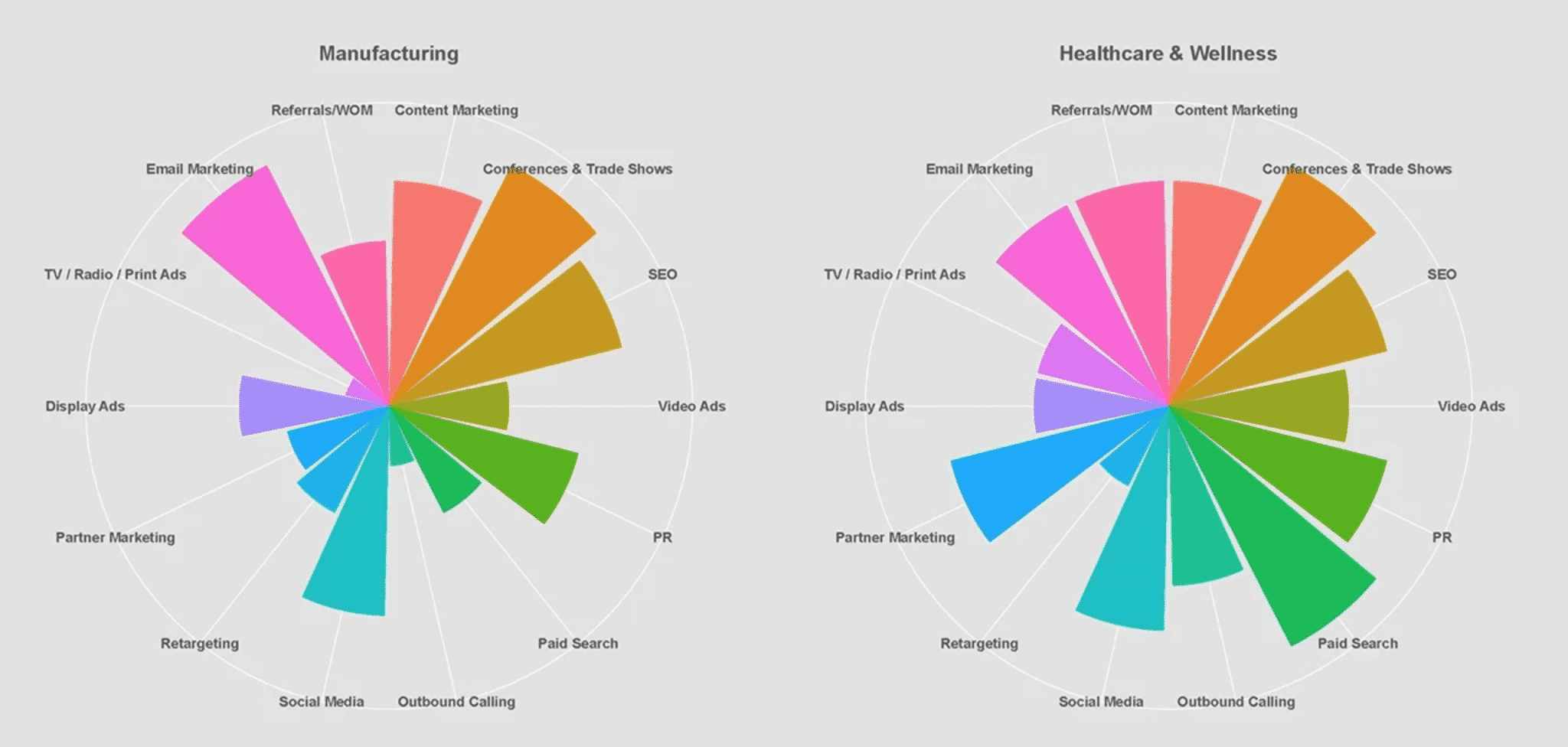Industry-Based Marketing: Take Your B2B Business to the Next Level
by Aden Andrus • June 30, 2020
B2B marketing can be tough. Unlike B2C marketing, where your target customers are often fairly similar—with regards to what sort of marketing they’ll respond to—your B2B audience may be much more fragmented.
Both home delivery pharmacies and an industrial piping company need shipping solutions, but they’re not looking for the same products or services. Even if you can meet both of their needs, it’s unlikely that they’d both respond well to the same marketing approach.
To further complicate things, customers in different industries expect to be marketed to in different ways. Some prefer email. Some like conferences. Some respond to PPC advertising. Others rely on word-of-mouth referrals.
If you rely on a “one size fits all” approach to B2B marketing, you may be able to land some sales, but you’ll miss out on a lot of potential opportunities.
This is why industry-based marketing is so important.
In this article, we’re going to talk about what industry-based marketing is, why it matters and what you need to think about to put an effective industry-based marketing strategy together.
What is Industry-Based Marketing?
In a nutshell, industry-based marketing is a marketing approach where you segment and specifically market to your potential customers based on their industry or vertical.
If home delivery pharmacies are an important market for you, you create a specific marketing strategy around the needs, pain points and preferences of home delivery pharmacies.
If industrial piping companies are also an important market, you create a separate marketing strategy that focuses on their needs, pain points and preferences.
This might seem like a fairly simple concept, but you’d be amazed at how many B2B businesses we’ve worked with who had been trying a “one size fits all” approach for years.

Once we started segmenting their strategy based on the needs and preferences of their key verticals, their marketing suddenly became much more effective.
Now, to be honest, good industry-based marketing takes a lot of work. It’s hard enough to build out one cross-channel marketing strategy. Multiply that by a dozen target verticals and you can see why so few businesses bother to implement an effective industry-based marketing strategy.
However, if you’re willing to put in the necessary work, the results are well worth the effort.
The simple fact of the matter is that your B2B customers are very discerning. There’s a good chance that you’re asking them to invest anywhere from hundreds-to-millions of dollars in your business. If they’re going to invest that kind of money, they want to feel like you truly understand their business and their needs.
[clickToTweet tweet=”To get your B2B customers to invest in your business, you have to make them feel like you understand THEIR business.” quote=”To get your B2B customers to invest in your business, you have to make them feel like you understand THEIR business.”]
If your marketing isn’t a good match, they’ll look elsewhere. You’ll lose out on their business…and all because you didn’t put in enough effort to effectively segment your marketing strategy.
Understanding Your Target Vertical
To be effective at industry-based marketing, you have to understand the issues and challenges your customers are facing in their specific vertical.
You’re still selling the same products, software or services, so there will be some overlap in pain points and needs between industries. But, if you don’t understand the priorities, values and problems your customers are dealing with, you’ll never be able to communicate with them effectively.
What Do Your Customers Care About?
To segment out your marketing strategy, you have to take a step back and look at your business from the perspective of your customers. Businesses in different verticals want different things from your business.
Going back to our home delivery pharmacy and industrial piping example, both of these companies need to get their products to a specific destination. They both need shipping containers. They both need their products to arrive safely and on-time.
However, the specifics they’re looking for in each of those three areas are very different.
A home delivery pharmacy is often shipping time- and temperature-sensitive products. The drugs they’re sending out could be worth thousands of dollars and if they are warm for more than an hour or so, they could be ruined.

With that in mind, a home delivery pharmacy is going to be looking for a delivery solution that can reliably get their shipments to their destination within 24 hours. They also need insulated shipping containers and ice packs. Finally, they need to be sure that their shipments won’t be left in a hot van for hours on end.
In contrast, an industrial piping company has very different priorities. Their products are large, unwieldy and heavy, so they are primarily interested in durable shipping containers and keeping their shipping costs down. They need their products to arrive on time, but they aren’t dealing with strict temperature challenges and their customers generally order well in advance.
As you can probably imagine, trying to appeal to both of these verticals with some sort of generic messaging would probably fall flat. In trying to appeal to everyone, you’d appeal to no one and lose both potential customers.
Adapting Your Marketing Strategy
When you only have one marketing strategy and message, it’s hard to straddle multiple industries with competing priorities. However, once you understand the priorities of your different verticals, you can use that knowledge to create vertical-specific messaging and then target each industry separately.
The good news is, the better you get to know your customers, the easier it is to find ways to segment your targeting.
Certain industries respond better to certain marketing channels. If you understand your target market and how to reach them, you can create a specific targeting and messaging strategy for that vertical.
For example, Bizible asked marketers in a variety of industries about which marketing channels they focused on. Here are the findings they reported for the manufacturing and healthcare industries (click to see the full-size image):
As you can see above, paid search is a huge marketing channel if you’re targeting the Healthcare & Wellness sector. If you’re targeting manufacturers, it may not be the best place to focus your efforts. However, email marketing is a great way to approach businesses in the Manufacturing space.
Building Out Your Strategy
Going back to our hypothetical shipping company, here’s how they might build out their industry-based marketing strategy for these two verticals:
- Target Industry: Industrial Piping Companies
- Primary marketing channels
- Email marketing
- Content marketing
- Conferences and trade shows
- Social media
- Search engine optimization
- Core messages
- We’re the most affordable way to ship heavy and bulky products
- Sturdy packaging solutions for large and small deliveries
- Reliable delivery times
- Trusted by piping companies across the nation
- Primary marketing channels
- Target Industry: Home Delivery Pharmacies
- Primary marketing channels
- Paid search
- Conferences and trade shows
- Public relations
- Content marketing
- Partner marketing
- Core messages
- Guaranteed next-day delivery, nationwide!
- Affordable insulated packaging options
- Specialized delivery vehicles and drivers
- Primary marketing channels
Obviously, this is grossly oversimplified, but it should give you a good sense for the thinking behind an industry-based marketing plan. Each segment is specific to the needs and preferences of that vertical or industry.
Once you’ve gotten to know your customers and built out your core strategy, you’ll then need to figure out how to implement your strategy across your different marketing channels.
The good news is, this should be fairly easy. Now that you have a good sense for who you’re targeting and what they care about, it’s simply a matter of identifying the best ways to get in front of them.
Figuring Out Your Target Industries
If you’re not sure which industries to target or how best to market to them, it’s time to sit down and do some research.
Take a look at your current client or customer list and ask yourself the following:
- Who are our best customers?
- Why do we love working with them?
- What industries are they in?
- What industries do we like working in?
- What types of businesses are the most profitable/produce the most revenue for us?
- If we could only market to businesses in one industry, which industry would we choose?
- If that industry wasn’t an option, what industry would we go after instead?
These questions should help you nail down which industries you should be targeting.
Even if you feel like you have a pretty good sense for your top industries, it still may not be a bad idea to reassess things. Sometimes, industries that were once great for your business have become less interesting. Other times, you may not realize where your sweet spot is until you take a step back and look at the data.

Once you know which industry you want to target, get on the phone and call up your best customers in that industry.
Try and get answers to the following:
- Why did you pick our business? What made us stand out?
- What problems does our business solve for you?
- What were you doing before you started working with us?
- Why do you love working with us?
- Where/how do you like to learn about suppliers/vendors/partners/etc?
Of course, these questions are just the beginning. The more you invest in getting to know your customers, the better you’ll understand their industry and how to market to other businesses in that vertical.
Conclusion
If you’re a B2B marketer and you haven’t tried industry-based marketing, it’s definitely something to consider. Even if you’re already trying some form of industry-based marketing, hopefully this article has given you something to chew on.
Industry-based marketing definitely takes more work than “one size fits all” marketing, but in our experience, it’s one of the best ways to get more out of your marketing budget.
Get to know your customers, identify your verticals and then build out campaigns around those verticals. Reap the benefits. It’s as simple (and complex) as that.
By the way, if you’d like help putting together an industry-based marketing strategy (or help with your B2B marketing in general), let us know here or in the comments. We’d love to help!
What do you think of industry-based marketing? Have you tried it before? What were your results? Any tips to share? Leave your thoughts in the comments.






